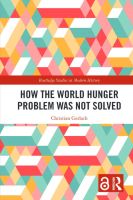How the World Hunger Problem Was not Solved
Proposal review
| dc.contributor.author | Gerlach, Christian | |
| dc.date.accessioned | 2024-02-06T08:59:48Z | |
| dc.date.available | 2024-02-06T08:59:48Z | |
| dc.date.issued | 2024 | |
| dc.identifier | ONIX_20240206_9781003849438_11 | |
| dc.identifier | OCN: 1396061291 | |
| dc.identifier.uri | https://library.oapen.org/handle/20.500.12657/87533 | |
| dc.description.abstract | The world food crisis (1972–1975) gave rise to new development concepts. To eradicate world hunger, small peasants were supposed to use ‘modern’ inputs like high-yielding seeds, fertilizer, pesticides and irrigation. This would turn subsistence producers into business owners, transform rural areas, invigorate national economies and the crisis-stricken world economy and thus stabilize capitalism. Together with an in-depth account of the world food crisis, this book analyses how this global scheme largely failed. It shows its diverse initiators, their reasoning and motives, its political breakthrough, the degrees to which it was implemented globally and nationally in the following decades and its socioeconomic effects in rural areas. Despite internationally coordinated policies and coercive means, the scheme failed on all levels: situation analysis, design, policies, incapable institutions (including big business), implementation and peasants’ responses. Selective realization in certain regions and for certain crops and the appropriation of funds by local elites often aggravated inequality and hunger. Case studies are about Bangladesh, Indonesia, Tanzania and Mali. The book shows limits to global social engineering, imperialism and state control. It is aimed at students, scholars, activists and non-specialists interested in development and the world food problem. | |
| dc.language | English | |
| dc.relation.ispartofseries | Routledge Studies in Modern History | |
| dc.subject.classification | thema EDItEUR::G Reference, Information and Interdisciplinary subjects::GT Interdisciplinary studies::GTM Regional / International studies | en_US |
| dc.subject.classification | thema EDItEUR::R Earth Sciences, Geography, Environment, Planning::RG Geography::RGL Regional geography | en_US |
| dc.subject.classification | thema EDItEUR::N History and Archaeology::NH History::NHH African history | en_US |
| dc.subject.classification | thema EDItEUR::N History and Archaeology::NH History::NHF Asian history | en_US |
| dc.subject.classification | thema EDItEUR::N History and Archaeology | en_US |
| dc.subject.classification | thema EDItEUR::3 Time period qualifiers::3M c 1500 onwards to present day::3MP 20th century, c 1900 to c 1999 | en_US |
| dc.subject.other | World Hunger | |
| dc.subject.other | International Politics | |
| dc.subject.other | Food Supply | |
| dc.subject.other | International Economics | |
| dc.subject.other | Modern History | |
| dc.title | How the World Hunger Problem Was not Solved | |
| dc.type | book | |
| oapen.identifier.doi | 10.4324/9781003450337 | |
| oapen.relation.isPublishedBy | 7b3c7b10-5b1e-40b3-860e-c6dd5197f0bb | |
| oapen.relation.isFundedBy | 3ef8d6fa-9f6b-4e9f-ad64-3b81b1bc829c | |
| oapen.relation.isbn | 9781003849438 | |
| oapen.relation.isbn | 9781032584928 | |
| oapen.relation.isbn | 9781003450337 | |
| oapen.relation.isbn | 9781003849476 | |
| oapen.imprint | Routledge | |
| oapen.pages | 626 | |
| oapen.place.publication | Oxford | |
| oapen.grant.number | [...] | |
| peerreview.anonymity | Single-anonymised | |
| peerreview.id | bc80075c-96cc-4740-a9f3-a234bc2598f1 | |
| peerreview.open.review | No | |
| peerreview.publish.responsibility | Publisher | |
| peerreview.review.stage | Pre-publication | |
| peerreview.review.type | Proposal | |
| peerreview.reviewer.type | Internal editor | |
| peerreview.reviewer.type | External peer reviewer | |
| peerreview.title | Proposal review | |
| oapen.review.comments | Taylor & Francis open access titles are reviewed as a minimum at proposal stage by at least two external peer reviewers and an internal editor (additional reviews may be sought and additional content reviewed as required). |

